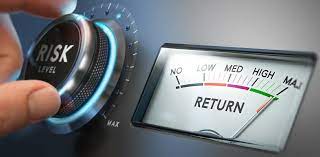Risk and Return
1. Risk and its measurement
Risk is the probability of variation in actual return from the expected return on investment. It is related to future uncertainty of gaining or losing of investment value. The basic principle of investment is higher the risk, higher is the profit (Fidelity International, 2017). Broadly the risk can be classified in two categories: systematic risk and unsystematic risk. Systematic risk is also known as market risk and it is uncontrollable. Unsystematic risk is a specific risk which is controllable through diversification.
Management of risk is very crucial in any investment decision and it starts with the measurement of risk. There are various methods to measure the risk level. The most commonly used method is computation of standard deviation and variance of distribution of return on investment. The standard deviation measures the volatility of returns or the degree of fluctuation of actual risks from the expected returns.
The higher value of standard deviation denotes higher volatility and thus depicts high level of risk whereas the low value of standard deviation denotes lower volatility and thus depicts low level of risk.
2. Source of firm specific risk and market risk
Firm specific risk is a risk which is specific to a particular firm or group of firms. It arises due to factors which are specific to a firm or group of firms. It is an unsystematic risk which can be controlled by making investment in portfolios instead of making investment in single security.
The main source of specific risk is business risk and financial risk. Business risk is the possibility of lower profits in a business than the expected one. It may be due to competition, low demand of product, high cost of production, bad management decision and input cost etc.
Financial risk is associated with liquidity position as well solvency position of company. In other words it is related to the capacity of the company to repay its short term liabilities as well as long term liabilities in time. For example, UK based banking organization Banco Espirito Santo (BES) failed in 2014 due to its financial irregularities. It is firm specific risk.
Market risk is the systematic risk which arises due to macro events which have impact on all firms (Weaver & Weston, 2001). The degree of impact may vary from industry to industry. It cannot be controlled with diversification that is why it is also known as undiversifiable risk. Sources of market risk can be any natural disaster, change in government regulation, political change, market recession, changes in foreign exchange rates and interest rates. For example, demonetization of currency in India in 2016 had same impact on all industries. It is market related risk.
3. Coefficient of variation
Coefficient of variation is a statistical measure which expresses the ratio of standard deviation to average return of the data distribution (Damodaran, 2014). It is calculated as follows:
Coefficient of variation = Standard deviation of data distribution
Mean of data distribution
It measures the dispersion of data points in a data distribution around its average. It is also known as relative standard deviation as it can be used to measure and compare the degree of variation of two different data series with different number of samples. The higher value of coefficient of variation depicts higher degree of variation and thus higher risk and vice versa. For example stock A has return of 8% and its standard deviation is 25%. Stock B has return of 9% and its standard deviation is 30%.
The coefficient of variation will be as follows:
Stock A = 25% = 3.13%
8%
Stock B = 30% = 3.33%
9%
The coefficient of variation of stock A is low as compared to stock B, so the level of risk is low in stock A as compared to stock B.
References
Damodaran, A. (2014). The Investment Principle – risk and Return Model. Retrieved from http://people.stern.nyu.edu: http://people.stern.nyu.edu/adamodar/pdfiles/acf3E/presentations/risk&ret.pdf
Fidelity International. (2017). About risk and return. Retrieved from https://www.fidelity.co.uk: https://www.fidelity.co.uk/investor/getting-started/the-basics/understanding-investing/property/risk-return.page
Weaver, S., & Weston, J. F. (2001). Finance and accounting for non financial managers (3rd ed.). New York: NY: Mc Graw Hill.
Want help to write your Essay or Assignments? Click here

